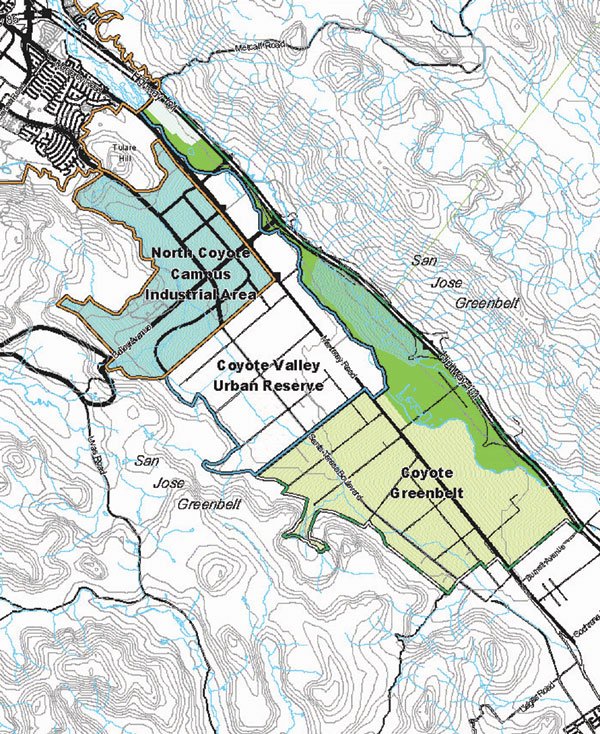San Jose
– Coyote Valley development plans cleared another hurdle Tuesday
night, gaining the unanimous blessing of the San Jose City Council
after nearly two hours of impassioned public criticism of almost
every aspect of the city’s ambitious dreams for its southern
edge.
San Jose – Coyote Valley development plans cleared another hurdle Tuesday night, gaining the unanimous blessing of the San Jose City Council after nearly two hours of impassioned public criticism of almost every aspect of the city’s ambitious dreams for its southern edge.
More than two years after city planners began work on the plan that Mayor Ron Gonzales called “solid, practical and visionary,” they are almost ready to study the feasibility of a smart-growth community that so far exists only in lushly-designed Powerpoint presentations.
The council’s decision allows the Coyote Valley Task Force to move ahead with more detailed financial planning and begin the environmental review process, and think more seriously about when they can break ground.
But before the vote came a parade of mostly frustrated citizens, and as it has throughout the planning process, the greenbelt, the so-called urban buffer zone between Coyote Valley and Morgan Hill, was the focus of most of the discussion.
Property owners, upset that development restrictions are holding down the value of their land, urged the city to alter its approach to the greenbelt, which makes up about half of Coyote Valley’s 7,000 acres.
They said the greenbelt isn’t so much green as it is a patchwork of disused and failing agricultural operations.
“It’s blight. Blight, blight, blight,” property owner Richard DeSmet said to applause. “It’s not a greenbelt.”
Cost estimates for initial infrastructure work in north and mid-Coyote, including laying water and sewer pipes, utilities and transportation, are in the $1.5 billion range. The city will not bear any of those costs, nor will it pay for the environmental review, which will be underwritten by the Coyote Housing Group, an association of home builders. At least two members of the Housing Group have representatives on the task force directing the planning process.
Greenbelt property owner Hong Quan criticized that arrangement with language invoking the Founding Fathers.
“They have been described as patient investors, ” he said, “What about the patient investors in the rest of Coyote Valley? These people have invested their lives and their futures. Annexation without representation is tyranny.”
Greenbelt owners are not alone in their frustration. City planners have been repeatedly criticized for drawing resources from development projects in other parts of San Jose, forcing Victory Outreach Church out of the greenbelt for land use violations, and ignoring the concerns of Morgan Hill. Officials from that city have threatened San Jose with litigation to hold up a plan they think will overwhelm Morgan Hill’s school district and harm South County’s rural environment.
The environmental impact report will get under way in a few weeks and should be finished by the end of the year. San Jose is also participating in more intensive state and federal environmental review processes that include Coyote Valley.
Some environmentalists have criticized the city for rushing the Coyote Valley EIR in order to evade potentially more stringent development restrictions that may come from the state and federal reviews.
And the Greenbelt Alliance believes that projects it calls “bells and whistles,” like a man-made lake that is supposed to beautify central Coyote and serve as a flood plain, will come at the expense of affordable housing and preserving open space.
A handful of people who stand to benefit from Coyote Valley development spoke up in support of the plan. Ken Saso, a task force member and a homeowner in mid-Coyote, praised the work of city planners and urged the council to approve the plan.
“You are all doing a great, great job,” Saso said.
Another long-time property owner from mid-Coyote, Frank Crane, said he and his neighbors “have paid our dues. We’ve got to move ahead.”
“I don’t want to see the greenbelt dispute hold up this plan,” Crane said.
Council members were significantly less vocal, though David Cortese, who represents parts of southern San Jose, suggested that city planners consider a a parallel ad hoc planning process with county officials and greenbelt owners.
“It seemed like 99 percent of the comments we heard tonight were about the greenbelt and 99 percent of those comments were about the process,” he said. “People feel like they’re in limbo.”
Laurel Prevetti, a deputy planner in charge of Coyote Valley, said that the task force will continue to work with greenbelt owners to satisfy their demands.
“We fully expect the plan to continue to change and be refined in response to our continued fiscal and environmental analysis. We want to remain flexible,’ she said.
The task force will return to council chambers in April with another progress report. Prevetti expects to ask for final authorization for development in March 2006. Infrastructure work may begin as soon as 2007.
The process continues
The next steps in the Coyote Valley Specific Plan Development Process:
• Spring 2005: The San Jose Planning Department will begin work on an environmental impact report. The project is expected to take about a year.
• February 2006: Tentative Recommendation for Specific Plan by San Jose Planning Department.
• March 2006: Tentative San Jose City Council Consideration of Specific Plan.
• 2007: Beginning of infrastructure projects, including sewage and water pipes.















